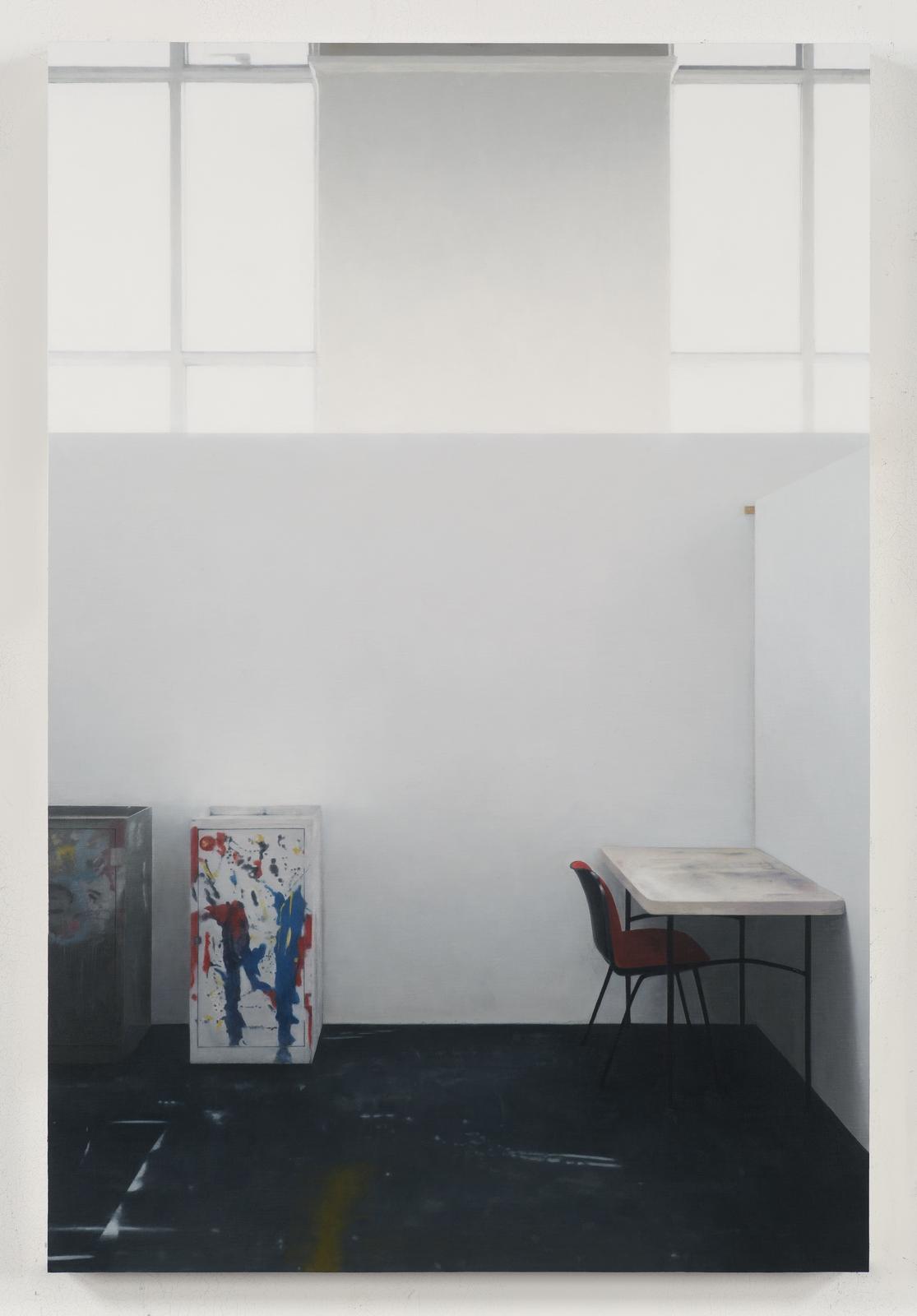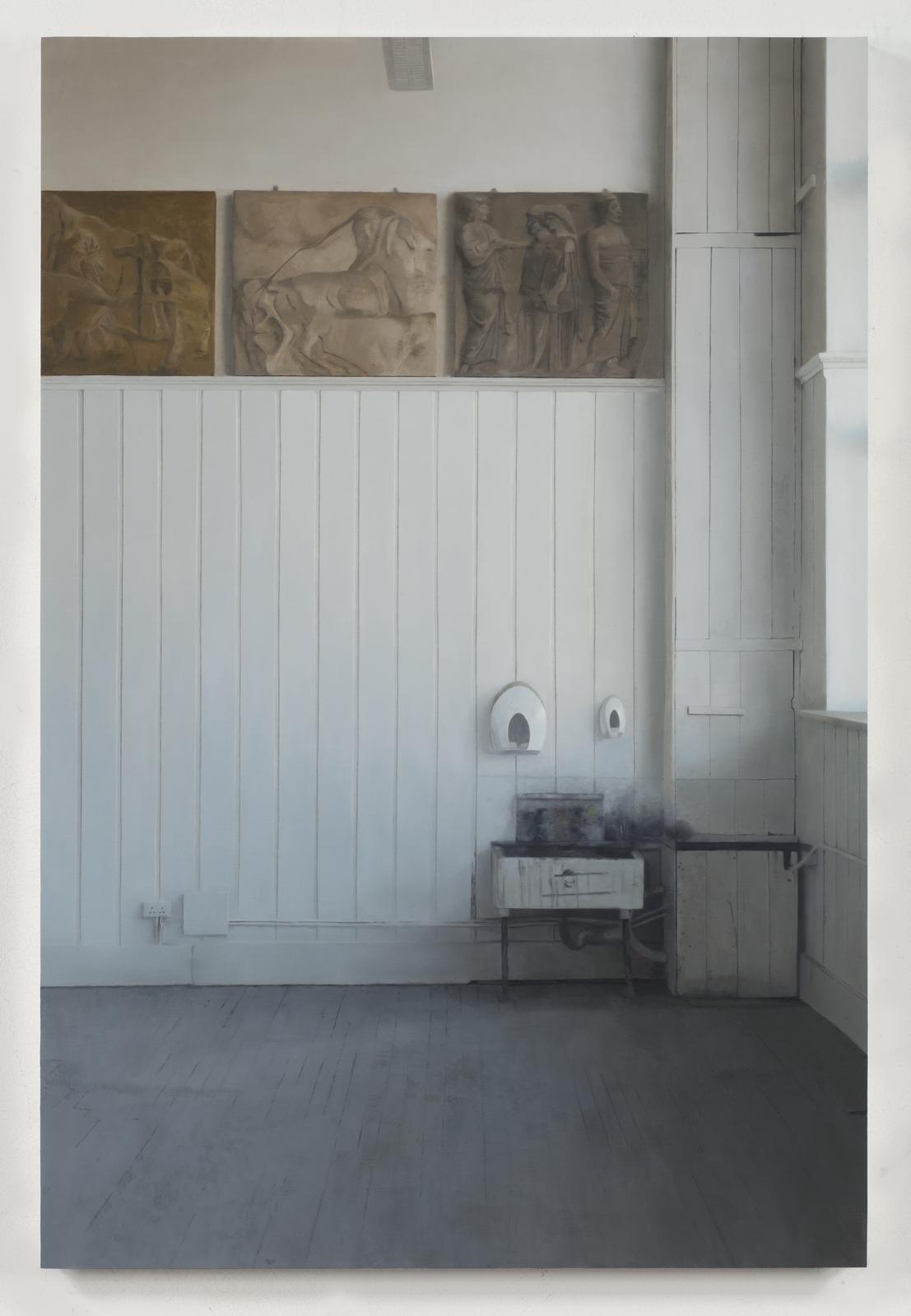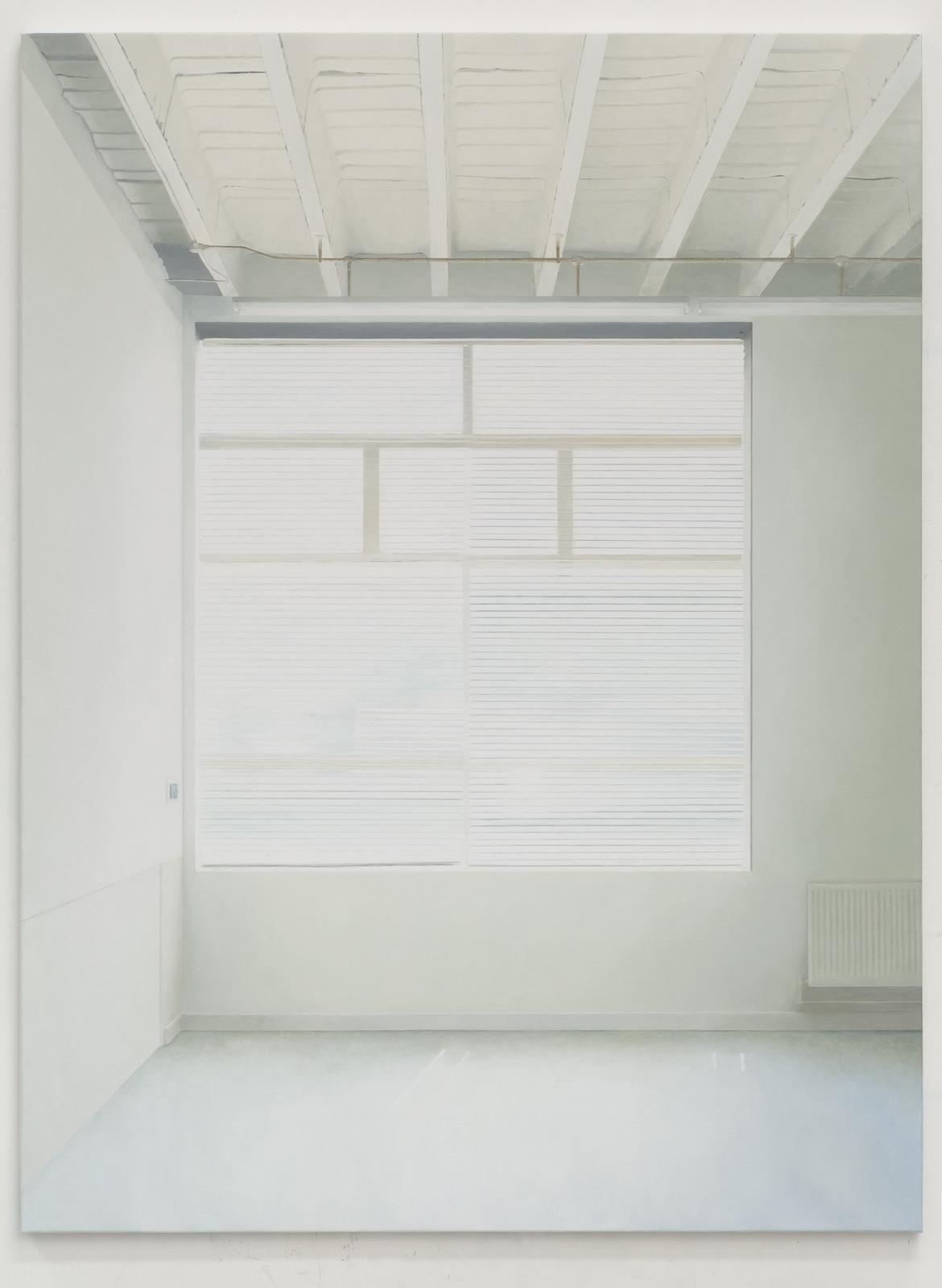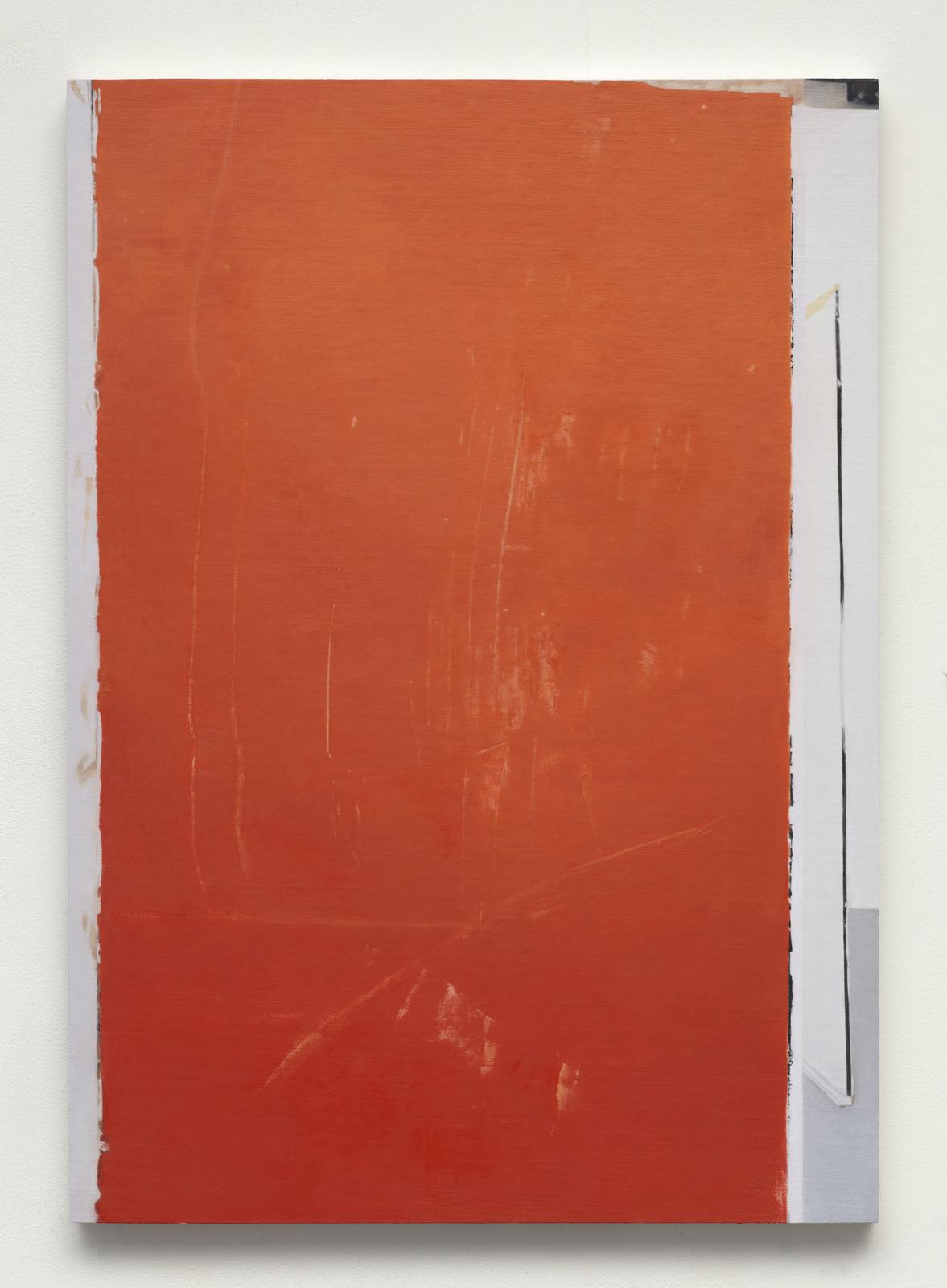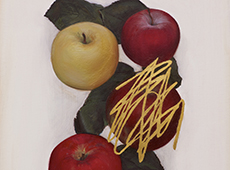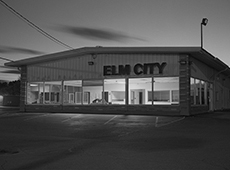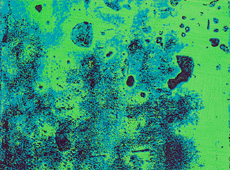Whereas I feel the photographs have a propensity to document, the paintings have no such obligation and as such they use the information in the photographs quite freely and make whatever is needed of the images. There is much re-drawing of the space, re-articulating, such as stepping back to get a slightly more distant view, changing the perspective, creating a more coherent geometry; replacing elements from other photographs, changing backgrounds, screens, table-tops; changing colour or disposition of light. Sometimes these changes are marginal, other times more dramatic. More particularly than any other series, these paintings have offered the opportunity to create real tension between the flatness and articulation of surfaces and the liminal qualities of spaces transformed by light.
© Paul Winstanley,
Courtesy of the artist and Mitchell-Innes & Nash, NY. Click to enlarge.
Richard Benari “Art School” began with your photographing of student studios across the UK in the summer months of 2011 and 2012. Why this project?
Paul Winstanley I’d had the idea for a long time to look systematically at the empty art school studio but had initially hesitated due to my feeling it might be too self-referencing of art, as a site of art. I have always shied away from such direct references, preferring to find subject matter amongst more commonly experienced places. But I was imagining an interior devoid of the usual stuff of furnishings, empty, painted out white but not anodyne. They were the only places I could think of like that. So I made some exploratory photographs in the summer of 2009, mainly to check that it wouldn’t work. But instead they surprised me. For such empty places they seemed full of detail and subtleties that, for the painter I am, offered much to get involved with. The idea grew from this point. I realised I would need the maximum amount of material I could get so planned to visit as many art schools as possible. The next opportunity I had was the the summer of 2011 followed by the summer of 2012. I became quite obsessive about it, taking a completist view, and visited every art school in Britain offering a degree level course in Fine Art and photographed their empty studios.
© Paul Winstanley,
Courtesy of the artist and Mitchell-Innes & Nash, NY. Click to enlarge.
RB There is a sense of absence in these pictures, a sense of urgent activity now stilled. Did you intend a subtext about the site of creative production—and the social and political content that much contemporary criticism assigns to depictions of such sites; or does the stillness of these rooms focus our attention purely on the activity of perception?
PW Content exists at many levels within the works and is dependent at least as much on the viewer as the artist. Whatever their references and qualities they are images of art schools that many will recognise, at least generically, and have views about. They show the organisation of teaching, how this interacts with the internal architecture, and this has a history and politics. People have fought hard for principles of art and how it should be taught. I can only say that the paintings are not polemical. The art school has provided the motif for the paintings and that is all. The viewer is, however, entirely free to make of them as they wish.
© Paul Winstanley,
Courtesy of the artist and Mitchell-Innes & Nash, NY. Click to enlarge.
RB These paintings do a kind of double duty. They are, for me, both realist paintings that achieve a kind of transporting atmospheric read; but they are also near-geometric abstractions that privilege the architectural planes of the site. Is this duality intended?
PW There is a reference to certain forms of abstraction here, particularly American, but also to historic European painting such as 17th century Dutch painting or 19th century Danish painting. Both these references have been strong elements in my work over a long time but in these paintings, with their stripped out, makeshift structures uncluttered by the usual stuff of interiors, the paintings can focus directly on this. It is to this end that the paintings are manipulated. The photographs do not have this ambition, cannot have it in many ways, but the paintings can and do. Abstraction is not a special or unique consideration. It is impossible to make paintings of any sort now without an internalised vocabulary of 20th century abstraction. This does not just speak to the organisation of a painting but to its self-referencing and identity as an object. These paintings are on panel and the edges reveal the wood and aluminium superstructure. They echo the surfaces being depicted within the imagery and make an abrupt disjuncture between the surface/image and the object. It heightens the meta-physical nature of the painting surface as a reflection of the depicted surfaces and space. Despite the prosaic nature of this subject matter it becomes unknowable.
Without having planned to, the photographs amounted to a kind of archive in the end, showing these places as they are. But they are not panorama shots so the images exclude much and frame the view as if in close-up. The images are vertically oriented presenting a sample of the space rather than a fully cognisant representation of it. This tends to foreground surfaces and is selective of other, deeper spaces. So from the beginning the images have a certain abstract quality to them though they are nevertheless documentary in nature. They show each studio situation as found and remain un-manipulated. As a documentary art project the photographs were published in book form (Ridinghouse, 2013, “Art School,” Paul Winstanley) — though the book undermines its indexing potential by providing a general list of the locations only and not identifying that of each image. The images coalesce into a super-attenuated art school environment within this context. It is a one-off project and the only time I have published photographs but its systematic rendering of the subject seemed to warrant this. The paintings led on from the photographs but they do a different job.
…these paintings have offered the opportunity to create real tension between the flatness and articulation of surfaces and the liminal qualities of spaces transformed by light.
© Paul Winstanley,
Courtesy of the artist and Mitchell-Innes & Nash, NY. Click to enlarge.
RB How do the finished paintings interplay with the archive of source photographs from which they are painted? You’ve recently published a large selection of these photographs–I believe some 240 images. Is this book a document of your process, or is photography, for you, an independent artistic medium?
PW Whereas I feel the photographs have a propensity to document, the paintings have no such obligation and as such they use the information in the photographs quite freely and make whatever is needed of the images. There is much re-drawing of the space, re-articulating, such as stepping back to get a slightly more distant view, changing the perspective, creating a more coherent geometry; replacing elements from other photographs, changing backgrounds, screens, table-tops; changing colour or disposition of light. Sometimes these changes are marginal, other times more dramatic. More particularly than any other series, these paintings have offered the opportunity to create real tension between the flatness and articulation of surfaces and the liminal qualities of spaces transformed by light.
[portfolio_slideshow id=9116 exclude=”9119,9132,9136,9142,9171″]
Paul Winstanley was born in Manchester in 1954 and lives and works in London. His work has been included in exhibitions since the 1970s, and over the past two decades it has been shown throughout the United Kingdom, Germany, France, and the United States. Recent institutional group shows include Art and Existence, Esbjerg Kunstmuseum, Esbjerg, Denmark (2013); Lifelike, Museum of Contemporary Art, San Diego, California (2012); and Window to the World, Museo Cantonale d’arte and Museo d’arte, Lugano, Italy (2012). His first retrospective was held at the Auckland Art Space in New Zealand in 2008 and was accompanied by a fully illustrated catalogue. Winstanley’s work is represented in numerous public and private collections, including the collections of The Irish Museum of Modern Art, Dublin; Tate Gallery, Great Britain; New York City Public Library, New York and the Museum of Contemporary Art, Los Angeles.
Paul Winstanley: “Art School” runs through 19 July at Mitchell-Innes & Nash, 534 West 26th St, NY.
Editor’s Recs:
View Paul Winstanley’s current exhibition at Mitchell-Innes & Nash, up through July 19, 2015.
Read Catherine Kinley’s exhibition text from Art Now: Paul Winstanley from the Tate Britain.
Watch Paul Winstanley in conversation with David Campany on the dynamic between painting and photography.
View more of Paul’s work at his website, www.paulwinstanley.com.
Subscribe to Tilted Arc
If you like this story, please consider subscribing. We are sticklers for privacy.
We will never sell or share your e-mail address.

